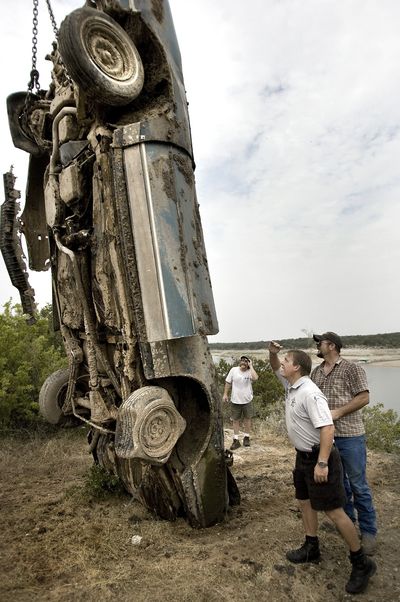Texas drought pinches water use
Extreme conditions in 77 counties; lakes yield cars

DALLAS – Off-duty police officers are patrolling streets, looking for people illegally watering their lawns and gardens. Residents are encouraged to stealthily rat out water scofflaws on a 24-hour hot line. One Texas lake has dipped so low that stolen cars dumped years ago are peeking up through the waterline.
The nation’s most drought-stricken state is deep-frying under relentless 100-degree days and waterways are drying up, especially in the hardest-hit area covering about 350 miles across south-central Texas. That’s making folks worried about the water supply – and how long it might last.
“The water table’s fallin’ and fallin’ and fallin’, like a whole lot of other people around here,” said Wendell McLeod, general manager of Liberty Hill Water Supply Corp. and a 60-year resident of the town northwest of Austin. “This is the worst I can recall seeing it. I tell you, it’s just pretty bleak.”
There are 230 Texas public water systems under mandatory water restrictions, including those in and near San Antonio, Dallas, Houston and Austin. Another 60 or so have asked for voluntary cutbacks. Water levels are down significantly in lakes, rivers and wells around Texas.
According to drought statistics released by the U.S. Department of Agriculture, 77 of Texas’ 254 counties are in extreme or exceptional drought, the most severe categories. No other state in the continental U.S. has even one area in those categories. John Nielsen-Gammon, the Texas state climatologist at Texas A&M University, said he expects harsh drought conditions to last at least another month.
In the bone-dry San Antonio-Austin area, the conditions that started in 2007 are being compared to the devastating drought of the 1950s. There have been 36 days of 100 degrees or more this year in an area where it’s usually closer to 12.
Among the most obvious problems are the lack of water in Lake Travis and Lake Buchanan near Austin, two massive reservoirs along the Colorado River that provide drinking water for more than 1 million people and also are popular boating and swimming spots. Streams and tributaries that feed the lakes have “all but dried up,” according to the Lower Colorado River Authority.
Lake Travis is more empty than full, down 54 percent. All but one of the 12 boating ramps are closed because they no longer reach the water, and the last may go soon. The receding waters have even revealed old stolen cars shoved into the lake years ago, authorities said.
There’s no threat to the area’s drinking water supply, said Bob Rose, a meteorologist with the river authority. But there are increased boating hazards from the “sometimes islands” that pop up when the water’s low, increased risk of wildfires, and more interactions between humans and wildlife.
“We’re seeing deer and armadillo and other animals in places we don’t typically see them,” he said. “They’re starving for water and food.”
San Antonio, which relies on the Edwards Aquifer for its water, is enduring its driest 23-month period since weather data was recorded starting in 1885, according to the National Weather Service. The aquifer’s been hovering just above 640 feet deep, and if it dips below that the city will issue its harshest watering restrictions yet.
There have been smatterings of light rain in the area in the past week, but not enough to make much difference.
But hopefully, the end is in sight. Victor Murphy, a meteorologist with the National Weather Service, said an El Niño system is developing in the Pacific Ocean. That phenomenon is usually followed by increased rainfall in Texas in the fall.